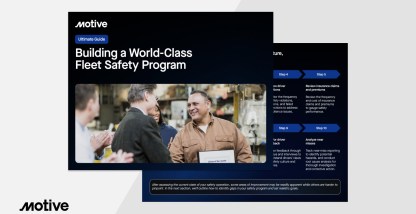With road risk on the rise for commercial workers, it’s more important than ever for fleet-based businesses to launch a safety program. And not just any fleet safety program – one that’s world-class. After all, dangers on the road don’t discriminate, so when it comes to protecting your team, you need to go the extra mile.
But before you can get a top-notch program off the ground, you have to understand where you stand on safety. A safety assessment is a big undertaking, but it doesn’t have to be overwhelming. With a step-by-step guide like this to help you, it won’t be.
Benchmark your current safety performance
Benchmarking isn’t a one-time exercise, it’s a continuous cycle of measuring, analyzing, and improving fleet performance. Companies benchmark for different reasons, mostly to identify gaps, set performance goals, and see how they measure up against industry standards. When done well, benchmarking should answer important questions about your safety performance, including:
- What kind of accidents are we most frequently having?
- How severe are they?
- Which unsafe driving behaviors are causing them?
- How often do accidents result in injury?
There are several ways to determine where you stand on safety and how much further you need to go. To understand how your program needs to mature, take the 10-step assessment below.

Identify gaps and set goals
After assessing the current state of your safety program, some areas of improvement may be readily apparent while others are harder to pinpoint. If you’re having difficulty, look for gaps in your program and set realistic goals.
As surprising as it may seem, physical economy businesses don’t always grasp the complexity of their most serious risks. Many perform well in one area but lack visibility and control in another. That’s why conducting an honest assessment, and working to identify gaps, is critical.
Whether you’re reviewing safety data, conducting driver surveys, or tracking near-miss incidents, your efforts to set specific goals for improvement will pay off. By addressing vulnerabilities in your program, you’ll prevent accidents, injuries, lawsuits, and damage to equipment.

Create a safety metric
Safety metrics are the key to tracking safety performance. Without them, safety managers are working in the dark, unable to know who’s excelling or in need of coaching.
To get the most from safety scores, it helps to know how to use them to your advantage. The most effective metrics evaluate driving performance over time. The Motive Safety Score, for example, gives an accurate measure of risk for each driver, based on how safe or unsafe their driving habits are. The Safety Score lets managers spot at a glance when a driver has improved, or needs to.

With today’s flexible coaching tools, safety managers can fully customize the weight of each driving behavior or turn behaviors off to better manage their safety program. Drivers, meanwhile, have full visibility into how they’re scored, with detailed behavior breakdowns.
Safety Scores show at a glance how your safety program is improving. Use them to measure the impact that coaching, safety policies, and tools like AI dash cams are having on safety performance. Track safety performance for your entire fleet or individually by driver.
Assessing your safety readiness is just the start of your road to safer performance. Ready to take your safety program to the next level? Download our Ultimate Guide: Building a World-Class Safety Program.










